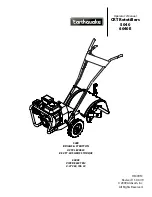
Slope Safety
•
Review the traction unit specifications to ensure
that you do not exceed its slope capabilities.
•
Slopes are a major factor related to loss of control
and rollover accidents, which can result in severe
injury or death. You are responsible for safe slope
operation. Operating the machine on any slope
requires extra caution.
•
Review and understand the slope instructions in
the manual and on the traction unit.
•
Evaluate the site conditions to determine if the
slope is safe for machine operation, including
surveying the site. Always use common sense
and good judgment when performing this survey.
•
Review the slope instructions listed below for
operating the machine on slopes and to determine
whether you can operate the machine in the
conditions on that day and at that site. Changes
in the terrain can result in a change in slope
operation for the machine.
•
Avoid starting, stopping, or turning the machine on
slopes. Avoid making sudden changes in speed or
direction. Make turns slowly and gradually.
•
Do not operate a machine under any conditions
where traction, steering, or stability are in question.
•
Remove or mark obstructions such as ditches,
holes, ruts, bumps, rocks, or other hidden hazards.
Tall grass can hide obstructions. Uneven terrain
could overturn the machine.
•
Be aware that operating the machine on wet
grass, across slopes, or downhill may cause the
machine to lose traction. Loss of traction to the
drive wheels may result in sliding and a loss of
braking and steering.
•
Use extreme caution when operating the machine
near drop-offs, ditches, embankments, water
hazards, or other hazards. The machine could
suddenly roll over if a wheel goes over the edge
or the edge caves in. Establish a safety area
between the machine and any hazard.
•
Identify hazards at the base of the slope. If
there are hazards, mow the slope with a power
walk-behind mower.
•
If possible, keep the attachment lowered to the
ground while operating on slopes. Raising the
attachment while operating on slopes can cause
the machine to become unstable.
•
Use extreme caution with other attachments.
These can change the stability of the machine and
cause a loss of control. Always keep the machine
in gear when going down slopes. Do not coast
downhill (applicable only to gear-drive units).
Operating the Attachment
Using the PTO
Before engaging the PTO, verify the following:
•
The angle of the pivot pins are 25° or less and
never exceeding 30°.
•
The pivot pins are aligned.
•
The overlap of the PTO cylinders is at least 150
mm (6 inches).
•
The PTO protection guard is not damaged.
Starting the Attachment
WARNING
Lifting the attachment too high causes the
PTO driveshaft knuckles to break.
Ensure that the attachment is not lifted higher
than is necessary.
Important:
The PTO can operate up to an angle of 25°,
but operating it beyond 30° angle may severely
damage the shaft (
).
g345626
Figure 23
1.
Breakage occurs here.
1.
Drive to the location where you will use the
attachment
2.
Inspect the area where you will use the machine
and remove all objects that the machine could
strike.
3.
Locate and mark all electrical or communication
lines, irrigation components, and other
obstructions in the area.
4.
Park the machine on a level surface and lower
the attachment.
5.
Engage the parking brake, shut off the engine,
and remove the key from the traction unit.
18
















































